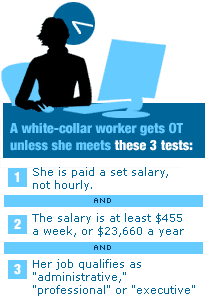NEW YORK (CNN/Money) -
Controversial new rules regarding overtime pay went into effect Monday, with the Bush administration and labor advocates squabbling over how many U.S. workers are affected.
The changes mark the first major overhaul of the federal overtime law in more than 50 years.
The Labor Department says the new rules will strengthen overtime rights for 6.7 million American workers, including 1.3 million low-wage workers who were denied overtime under the old rules.
But groups, including the AFL-CIO, say the rules will bar 6 million workers from getting time and a half. There's a Capitol Hill protest of the rules scheduled Monday.
In Saturday's Democratic Party radio address, vice presidential candidate Sen. John Edwards blasted the rules.
"Why would anyone want to take overtime pay away from as many as 6 million Americans at a time when they need that money the most?" Edwards asked.
But legal experts agree that the rules are still so gray that it's hard to know which side of the debate is right.
"I'm skeptical," said employment lawyer Robert Whitman, referring to all the rhetoric. "It's very hard to generalize about this. The Labor Department did not come out and say 'the following 50 job titles are automatically exempt or non-exempt (from overtime pay)," said Whitman, a partner in the New York office of Orrick, Herrington & Sutcliffe. "That's not possible to do."

Under the law, there are three primary tests for determining who is eligible ("non-exempt") and who is not ("exempt") from overtime pay.
First up is the "salary-basis" test. To be exempt from overtime, workers must be paid a set salary, not an hourly wage. This has long been the rule under federal overtime law. The new rules don't change this requirement.
The second criteria, called the "salary-level" test, has been amended. In order to be exempt from overtime, the new rules require that employees earn a minimum salary of $455 a week, or $23,660 a year. That's triple the prior minimum salary of $155 a week, or $8,060 a year.
| 
| |

| 
| 
|

|
 The nation's workers and employers face a brand new set of overtime regulations. CNNfn's Louise Schiavone looks at the new rules and the debate. The nation's workers and employers face a brand new set of overtime regulations. CNNfn's Louise Schiavone looks at the new rules and the debate.
|
 Play video
Play video
(Real or Windows Media)
|
| 
|

|
|
White-collar employees who earn more than $100,000 a year are automatically exempt from overtime pay under the new law. That wasn't the case before, although many high-income workers have been exempt for other reasons besides their income level.
The third test is where the rules get considerably more complicated -- and controversial. The final prong is called the "duties" test. It tries to establish eligibility based on the type of work an employee performs every day. Under federal law, a worker whose job is deemed "administrative," "professional" or "executive" in nature does not qualify for overtime. The categories themselves won't change.
Instead, the new rules aim to clarify the type of work that qualifies as administrative, professional and executive. For example, under the executive exemption, a fast-food manager who is involved in key staffing decisions like hiring, firing and promoting may no longer be eligible for overtime pay. Previously, that fast-food manager had to have the actual power to hire and fire employees in order to be considered exempt.
Overtime rules have long been contentious, with labor unions seeking more time-and-a-half coverage for workers and businesses wanting to restrict non-exempt employees. While both sides agree that the rules, which have not been revamped since 1949, were outmoded, they have disagreed vehemently about what aspects of the rules need changed.
Labor unions sought increases in the minimum salary levels necessary to be considered exempt, while business interests lobbied for an overhaul of the "duties" test.
Every administration since President Jimmy Carter has tried to rewrite overtime rules, but efforts failed because the issue is so politically contentious.
Since the mid-1990s, however, litigation between employers and their workers over time-and-a-half eligibility has exploded. Many companies like Starbucks, Wal-Mart and Taco Bell have been sued by workers who claim their employers have taken advantage of the outmoded rules to deny them overtime pay. After a series of multimillion-dollar jury verdicts and settlements, business groups demanded that the Bush Administration rewrite the rules.
The rules that took effect Monday have undergone several revisions in the 18 months since they were first proposed.
J. Craig Shearman, the vice president for government affairs at the National Retail Federation, said retailers, who have been especially hit hard with lawsuits, are pleased with the new rules. Among other things, he said they simplify overtime classifications by relying less on job titles and more on actual duties.
"We're very happy to see the update," he said.
Labor unions, meanwhile, vow to continue waging battles in court for overtime pay. And if Democrats retake the White House in November, it's likely that the new rules will be further revised in order to placate workers.
Another factor that could dampen the impact of the new regs is state law. Some 18 states, including California and Illinois, have separate overtime laws that trump federal law, according to Amy Bess, an employment law partner at Sonnenschein Nath & Rosenthal in Washington, D.C.
The federal rules that took effect Monday will not affect workers in those states.

-- CNN/Money's Krysten Crawford contributed to this story
|

